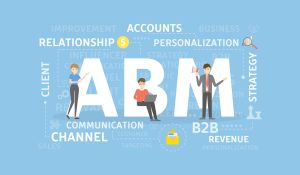
Account-based Marketing has been the favored marketing strategy for B2B marketers for many years. Over time, it has gained widespread acceptance and is employed by both small and large companies as the top-tier approach for selling and as a best practice in sales and marketing.
B2B ABM is all about using various criteria, such as value, to identify critical clients and then spending most of the budget on developing customized engagement strategies for those accounts. Of course, the profiling procedure must be effective and must help select the right accounts.
It isn’t surprising that the success of B2B Account-based Marketing solutions hinges on the C-Suite executives. But how do marketers get in touch with C-suite executives? It is challenging considering their hectic schedules or their PAs keeping a close watch on their meeting schedules. If you are lucky enough to schedule a meeting with C-suite executives, you will only have a few minutes of their time. This is quite a dilemma, given that most high-value sales require approval from a C-suite executive.
In such times when C-suite executives play a crucial role in sales success, how do marketers solve the conundrum? Read this blog to know why it’s difficult to close C-suite executives and what to do about it. We will also deliberate three important steps to help marketers target and sell to the C-Suite.
IN THIS BLOG
Who are C-Suite Buyers, and Why Are They Difficult to Convert?
In plain words, C-Suite people are the topmost executives in a company. Below we have mentioned the names of a few:
- Chief Executive Officer (CEO)
- Chief Financial Officer (CFO)
- Chief Marketing Officer (CMO)
- Chief Technology Officer (CTO)
- Chief Data Officer (CDO)
These executives are core members accountable for furthering an organization’s purpose and vision. They play a significant role in formulating top-level policy and strategy and ensuring that managers and other executives embrace and implement the same.
Additionally, C-suites have the last say on significant procurement choices. Still, a lack of awareness and information prevents salespeople from targeting C-Suite leaders. And when they finally get in touch with them, they face several performance obstacles. A lot depends on the client’s perception of your value proposition and, of course, mannerisms or professional ability.
Profiling C-Suite Decision Makers
C-Suite buyers fall under the following categories:
Main stakeholders:
These are the foremost upholders in your B2B ABM account, and they must be highly considered. They have a direct stake in the transaction as they benefit directly from it. Examples include supply chain managers, business analysts, and human resource managers.
Influencers:
Executives at the top level usually influence purchase decisions. Influencers, too, can be the champion, depending on the firm’s structure or your product/solution.
Additionally, a C-Suite CEO with an inclusive leadership style may appreciate the opinions of the subordinate. A wise salesperson must target such an influential subordinate.
Finance buyer:
The finance buyer is authorized to approve any kind of transaction. Although they are not directly engaged in purchase meetings, they can veto a purchase if they are unhappy with a product’s relevance or contribution to business value. The key to winning a buyer is metrics such as Return on Investment (ROI). The chances of meeting this buyer are high when someone sells a complex solution or one that has a greater ROI.
Technical expert:
Security, compliance, and legal issues, especially related to IT, are the prime focus for this buyer. You can impress this buyer successfully only when all compliances are adequately addressed, so you must meet these requirements.
Engage: Various Channels to Engage C-Suite Buyers
Your engagement strategy is very important when you try to engage C-Suite buyers, but equally important is which channels you include. Below are a few effective channels that can be used:
Email:
B2B Lead generation campaigns must address the target account’s pain points in the initial emails. This is true for ABM lead generation campaigns for two reasons: One, only a few accounts are dealt with, and two, data is user-specific. Resolving pain points demonstrates that:
- You are aware of your prospects’ difficulties.
- You are the best individual to assist them in addressing their problem.
Website:
To suit every target account, tailor your message on the website. A fantastic method to do this is to use specific landing pages.
Webinars:
In times when one wants to provide in-depth training on various product elements, webinars are a great option. Additionally, webinars are ideal for onboarding new clients and maintaining relationships with existing ones.
How to Effectively Close C-Suite Leads
Even though selling to the C-Suite might be daunting, doing so is essential if you want to be a successful seller. Below are a few tips that can help you pitch appropriately and take your selling to the next level.
Practice SNAP selling:
SNAP selling’s technique is predicated on the notion that modern sales representatives interact with prospects who suffer from “frazzled customer syndrome.” This technique makes selling to the C-suite less daunting.
Selling to disinterested and stressed-out customers calls for a customized strategy involving four simple stages.
Simplifying: The purchase process should be simple for the buyer. Complex approaches make decision-making complex and time-consuming. It will also complicate consumers’ propensity to adopt the solution.
Be invaluable: Can you demonstrate the actual value of your product/solution? Emphasize the special features of your product to make its value stand out.
Align: Your product or service should address the issue that the consumer is attempting to solve.
Prioritize: Find out the topmost priority for your buyer. Make your product a priority for your buyer.
Pay for high-quality leads:
Direct phone calls result in four to six times more connections than prospecting without a phone call. But direct calling cannot be successful unless you have a reliable, accurate contact database. Therefore, work closely with a reliable data provider to get contacts for B2B marketing qualified leads. This will lead to higher connect rates, shorter selling cycles, and closing rates.
Keep an eye on changing trends:
Continuous changes within the industry or organization can create new buying opportunities that can be leveraged. You can take the benefit of this situation. To cite an example, a firm may change its compliance parameters in a bid to enhance transparency. This is an opportune time for you if your company’s product can assist the lead in addressing compliance difficulties.
Leadership changes can also generate excellent sales opportunities. Frequently, new leaders want to improve performance by introducing improved procedures, technologies, and operating strategies. Monitor such changes in leadership and approach them to determine whether your solution may contribute to their professional success. Google alerts may be used to monitor events occurring online. You will receive updated information and insights as a result.
Wrapping
It’s undeniable that C-suite executives play a pivotal role in ABM selling, holding the highest decision-making authority in any business. The initial step in effectively selling to the executive suite involves comprehending your target audience. A B2B account-based marketing company can assist you in identifying, profiling, and engaging with your target accounts. Remember that ongoing enhancement of your sales skills is essential to effectively secure a higher number of C-Suite accounts.
If you require assistance with ABM lead generation, please don’t hesitate to reach out to us at your convenience.








